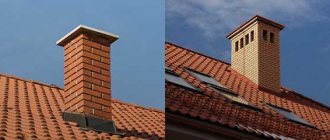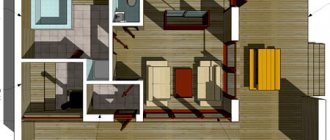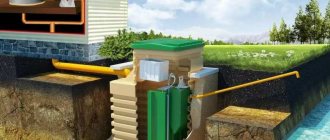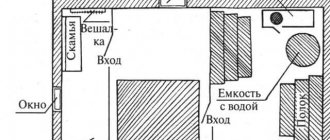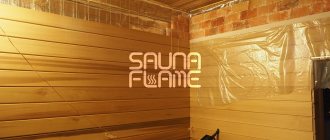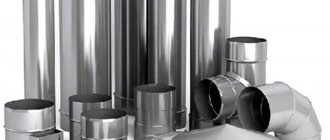Here you will learn:
- Calculation of chimney parameters
- Types and designs of steel chimneys
- Advantages of a steel chimney pipe
- Advantages and disadvantages of sandwich chimneys
- Installation recommendations
- Installation of a sandwich system for smoke removal
- Maintenance of the assembled system
The installation of heating devices is subject to the requirements set out in the regulatory documentation.
Installation of devices is regulated by the provisions of SNiP 2.04.05–91 and DBN V.2.5-20-2001. Also, before drawing up a project, it is advisable to study materials on heating systems (SNiP 41-01-2003), on heat generation devices (NPB 252–98), on technical conditions for the operation of heating devices (GOST 9817–95), on the rules and regulations for the operation of smoke ducts (VDPO).
The design of the chimney and installation features must fully comply with the requirements specified in SNiP, otherwise you will not receive a construction inspection certificate, which is issued after commissioning
Some of the requirements are addressed specifically to the installation of chimneys. The design of the structure can be anything, but the material must be non-flammable.
The materials used for the construction of chimneys can be:
- steel;
- ceramics;
- brick.
Without exception, all structures are prefabricated, and the installation itself is fragmentary, since the chimney passes through several rooms (for example, a room and an attic).
In order for a structure to meet fire safety requirements, its parameters must be correctly calculated, and all component parts must be sized accordingly. When installing factory equipment, you must follow all the recommendations set out in the instructions, including the assembly procedure and methods for installing parts.
A brick pipe is a classic option for a solid fuel system, in which the flue gas temperature reaches 500-700º. Laying it is a labor-intensive process, but if you follow the rules, it can be done with your own hands
A chimney with characteristics as close as possible to a brick pipe can be made from modules of a ceramic chimney system
The construction of a metal chimney from ready-made pipes is simpler and faster than all types of chimneys currently used. However, in solid fuel systems they try not to use this option, because metal pipes burn out quickly and require frequent replacement
One of the modernized variations of a metal pipe is the sandwich chimney. Due to its special design, its service life is increased and its technical performance is improved. Brick pipe of a solid fuel system.
The documentation contains certain provisions that also need to be taken into account, for example:
- the length of the chimney can be any, but not less than 5 m (the height of the ventilation ducts is not less);
- the cross-section of the pipe must correspond to or exceed the inlet hole in the generator;
- each heat generator requires a separate chimney;
- the speed of flowing air inside the pipe is from 15 m/s to 20 m/s;
- the thickness of the pipes is determined by the material of manufacture (the norm for steel is at least 0.5 mm);
- for regular inspection and cleaning activities, chimneys are equipped with pockets (niches) 0.25 m deep;
- the maximum number of chimney turns is 3;
- the radius of curvature must exceed the diameter of the channel;
- the height of the pipe above the roof is regulated by the roof structure: on a flat one – 0.5 m; 0.5 higher than the roof if it is located at a distance of 1.5 m (or less) from the ridge; equal to or greater than the ridge axis if located at a distance of 1.5-3 m.
The order of construction of the structure has been established - always from the bottom up, that is, from the heat generator (boiler, furnace) through the floors to the roof. In prefabricated structures, each subsequent pipe part is inserted into the previous one.
The operating temperature of sealants used to fix parts must be at least 1000º. The connections are equipped with clamps on the outside; fastening material should not get inside the chimney.
Support brackets are provided for fastening the tee, and in order to avoid sagging of the channel, clamps must be fixed to the wall every 2 m to support the pipe
The regulatory documentation defines the places where chimneys are allowed to be installed. The wall material must be non-flammable, but if this condition is not met (for example, in a building with wooden walls), then during installation, for protection purposes, cap or crown pipes should be used.
Calculation of chimney parameters
The basis for calculating the height and diameter of the chimney is the power indicator.
The performance of a boiler or furnace is directly affected by the height of the chimney. For household appliances it is 5 m. This characteristic is provided for by the SNiP requirements for stoves in residential buildings. The measurement is taken from the device's grate to the hood. At a lower altitude, the natural draft in the stove will not ensure efficient combustion of fuel; it will smoke and not produce the optimal amount of heat. However, the ability to increase height is limited. Experiencing the natural resistance of the pipe walls, the air will slow down if the channel is too long, which will also lead to a decrease in draft.
Rules for selecting chimney length
For a private house, calculating the height of the chimney is based on certain rules:
- The pipe must be at least 5 m.
- The excess of the chimney end above a conventionally flat roof is at least 50 cm.
- For a pitched roof, a pipe whose axis is located no further than 1.5 m from the ridge, and if there are superstructures, then from their highest point, the excess is 0.5 m.
- When the distance to the ridge is 1.5–3.0 m, the end of the pipe should be no lower than the level of the ridge.
- When installing a chimney at a distance of more than 3 m from the ridge, in particular for outdoor installation, the angle between the horizon level and the conventional straight line between the ridge and the end of the pipe must be at least 10 degrees.
The height of the pipe depends on its location
When choosing a location for the chimney outlet through the roof, it should be taken into account that it should not be located near roof windows and other similar devices in order to avoid creating fire hazards.
Calculation of the chimney cross-section
The procedure given below for determining the size of the channel is valid for a circular cross-section. It is the optimal form, since the flue gases do not move in a monolithic straight stream, but the flow swirls and they move in a spiral. In rectangular channels, vortices are formed at the corners, inhibiting the movement of gases. To calculate the cross-sectional value, the obtained result should be multiplied by 1.5.
You will need the following initial data:
- Furnace power, that is, the amount of heat generated by the device per unit time when fully loaded.
- The temperature of the flue gases at the outlet of the furnace is usually taken to be within 150–200 degrees.
- The speed of gas movement through the channel (is 2 m/sec).
- Chimney height.
- The value of natural draft (4 MPa per 1 m of smoke channel).
The dependence of the cross-sectional area of the chimney on the volume of fuel burned is obvious.
Smoke doesn't move in a straight line
To perform the calculation, you need to use the converted formula for the area of a circle: D2 = 4 x S * Pi, where D is the diameter of the smoke channel, S is the cross-sectional area, Pi is the number pi equal to 3.14.
To calculate the cross-sectional area, you need to determine the gas volume at the point where they exit from the stove into the chimney. This value is calculated depending on the volume of fuel burned and is determined from the ratio Vgas = B x Vtop x (1 + t / 273)/ 3600, where Vgas is the volume of gases, B is the amount of fuel burned, Vtop is a tabular coefficient that can be found in GOST 2127, t - temperature of gases at the outlet of the furnace, usually a value within 150–200 degrees is accepted.
The cross-sectional area is determined by the ratio of the volume of passing gases to the speed of its movement, that is, by the formula S = Vgas/W. In the final version, the desired value is determined by the relation D2 = Vgasx4/PihW.
Having made the necessary calculations, you will get the result - the diameter of the chimney should be 17 cm. This ratio is valid for a stove in which 10 kg of fuel burns per hour with a humidity of 25%.
The calculation is made for cases where non-standard heating units are used. If the power of the device is known, it is enough to use the chimney parameters recommended by experts:
- for devices with power up to 3.5 kW - 140 x 140 mm;
- at 3.5–5.0 kW - 140 x 200 mm;
- with a power of 5.0–70 kV - 200 x 270 mm.
For chimneys with a round cross-section, its area should not be less than the calculated size of a rectangular one.
Video description
You can see the chimney outlet through the wall in a bathhouse in this video:
- the upper part of the structure is located slightly above the roof ridge so that the smoke is blown away by the wind;
- there should be no other communications or wires near the box through which the pipe is inserted;
- Regardless of the material of the chimney, its horizontal part is inserted into the wall at a right angle.
Before making a chimney through a wall in a wooden house, you should treat it with an antiseptic and a liquid that increases its resistance to fire.
Types and designs of steel chimneys
Chimneys are made from the following types of steel:
- Alloyed (with and without enamel coating).
- Mirror stainless steel.
- Galvanized.
Steel chimneys come in 2 models:
- Single-walled (single-pipe). Simple rigid or flexible corrugated pipes and shaped elements for them with a thickness of one wall (0.5 - 1.5 mm) can withstand heating up to 1100⁰C. Mainly used as liners in brick chimney shafts. They can also act as an independent structural element, but in this case it will be necessary to carry out additional work on their thermal insulation and insulation.
- Double-walled (two-pipe). So-called sandwich or coaxial chimneys consist of two pipes of different diameters and, as a rule, different levels of heat resistance, inserted into one another.
The space between them is filled with fire-resistant insulating material (most often basalt mineral wool), which performs several functions:
- Insulation of the pipeline when it is placed outdoors.
- Prevents condensation.
- Ensuring a normal level of traction.
They are distinguished by a longer period of operation, as well as originality and aesthetics, which eliminates the need to cover them with a decorative casing.
Chimneys also differ according to the type of structural solution:
- The location of the chimney circuit is inside or outside the room. Placing a chimney in a house is a more labor-intensive process, which involves laying it through the ceilings and exiting through the roof. In many ways, this concept is justified by the high heat saving coefficient and the ability to arrange the simplest and most efficient straight, strictly vertical configuration. However, this method is the most fire hazardous; in addition, the pipe eats up useful space in the rooms through which it passes.
Exiting the pipe to the street through a hole in the wall of the house and attaching it to the facade using brackets significantly reduces the fire hazard index. However, in this case, additional work will be required to insulate the circuit, and in areas with severe frosts, it becomes necessary to construct an external brick shaft as a complementary insulating casing.
- According to the angle of inclination of the contour into: upright (strictly vertical), inclined and containing horizontal sections. The first option is considered the most effective. Slopes and horizontal planes impair traction in the circuit, so their installation must be carried out in strict accordance with building regulations.
- The shape of chimneys can be round, oval, square and rectangular. The best is considered to be a round cross-section, which has excellent aerodynamic characteristics. Square and rectangular formats help reduce the speed of movement of the air mass inside the contour due to the formation of turbulence in the corners. In addition, it is in the corners that more soot is deposited.
Selection of insulating materials
So , how to properly install a stove in a house with a chimney through the wall is already clear, so you need to consider the issue of insulating the outer part of the structure. If a sandwich system is used, then this procedure need not be carried out (except for the place where the element passes through the wall). The insulation must be fireproof. It is allowed to use the following materials:
- Stone wool. This is the best option for a wooden house. The material is easy to use, does not contain harmful substances, does not burn or smolder. Cotton wool not only does not burn, but also prevents the spread of open flames.
Insulation of structures on the street Source teplo.guru
- Asbestos. Many masters refuse to use it. The material contains toxic carcinogens. However, it has high insulating qualities and does not come into contact with humans in any way.
- Superpower. Modern insulation, which does not burn, provides good insulation. The disadvantage of the material is its high cost.
- Basalt cardboard. It is characterized by a long service life. The insulator is relatively cheap and resistant to high temperatures. The material contains no toxic substances, and its quality is better than mineral wool.
The insulated structure may not look very presentable, but this stage cannot be avoided. Without insulation, condensation will collect inside the structure. It will not only deteriorate moisture, but will also have a negative effect on the metal.
Advantages of a steel chimney pipe
Chimney pipes are made of metal, ceramics and brick. Metal pipes are currently in greatest demand. Of all the varieties of this material, it is recommended to choose steel. Steel pipes for chimneys are coated with special solutions that make the material resistant to all adverse effects of the internal environment of the chimney.
When choosing a pipe, it is necessary to take into account the parameters of the heating devices and the fuel used. The material from which the pipes are made must withstand higher temperatures than the fuel can create.
When using some types of heating devices, chemically active substances are found among the under-oxidized combustion products. They can damage a chimney that is not sufficiently resistant to chemicals. Some unburned particles can ignite, creating sparks. Therefore, the material from which the pipe is made must be fireproof.
This is interesting! When choosing a pipe, you need to pay attention to the melting point of the material from which it is made. The melting point of steel exceeds 1000 0C - the highest possible indicator encountered when operating heating appliances powered by coal.
The advantages of steel pipes are:
- Easy to install. Steel pipes do not require the installation of a special foundation; they do not require complex engineering solutions or special installation tools. You can install them yourself without prior preparation. Due to the plasticity of the material, complex technical structures can be created.
- Light weight. They are easy to transport, you can lift and move them yourself without a team of workers, which also simplifies installation.
- High temperature resistance. Steel products are suitable for appliances operating on any fuel. They do not melt at maximum temperature loads.
- Chemical inertness. Steel does not interact with chemical reagents that can form as under-oxidized combustion products. These substances are not capable of destroying it.
- Corrosion resistance. This advantage applies to pipes that have a special coating and stainless steel. The material itself quickly corrodes. It is worth considering that in addition to the internal environment, the chimney pipe is affected by external unfavorable factors, for example, precipitation. Preference should be given to coated pipes.
- Smooth inner walls. Combustion products settle on the rough surface, turning into soot, which gradually reduces the clearance. This reduces the draft in the chimney. Steel is completely smooth, the risk of soot settling on their surface is minimal.
We recommend reading: Why heating pipes in an apartment make noise or hum, and how to fix it
Tools for work
You won't need many tools for laying stoves. This is a trowel (a special trowel for laying bricks), a container in which the clay mortar will be mixed, a drill with a “mixer” attachment for mixing it (although you can do without it) and a building level to control the evenness of the masonry and check the geometry of the furnace.
Despite the fact that the stove is a fairly simple geometric figure, it is still worth keeping an eye on the level. because the mortar can be heterogeneous, its thickness can vary from row to row, and the brick always strives to “move” somewhere. When building “by eye”, the entire structure often “collapses” in one direction.
Advantages and disadvantages of sandwich chimneys
In industrial conditions, stainless steel products are used for the inner layer of the sandwich, and zinc-coated steel pipes are used for the outer layer. In this case, the inner contour is covered with thermal insulation and placed inside the outer cylinder. As a result, such a structure functions quite efficiently and efficiently.
Please note that industrial sandwich pipes are sold in lengths up to 1 m.
Installing a chimney made from sandwich products does not take much time and effort - all the work can be completed in a day. Below we present a number of advantages and disadvantages of such pipes.
Among the advantages of such structures are:
- multitasking - such pipes can be used in buildings made of any materials;
- occupy a minimum of space;
- ease of transportation;
- Even a beginner in construction can install sandwich pipes, as it is very simple and quick;
- laconic and pleasant appearance;
- fire safety - this is one of the best options for chimneys in this regard;
- the existing roof truss system does not create any obstacles to the installation of a sandwich pipe;
- due to the presence of several layers, much less soot accumulates in such a pipe and almost no condensation forms, so cleaning it is required much less frequently;
- The sandwich pipe is capable of fully protecting residents from the influence of toxic combustion products.
But such designs have very few disadvantages, although they still exist:
- the price of a sandwich pipe is quite significant;
- The optimal service life of such products is only about 15 years.
If you want to make a sandwich pipe with your own hands, then such a chimney will cost you much less than, say, one made of brick. This will result in a completely reliable chimney, and there should be no difficulties with installation and assembly.
Briefly about the main thing...
Chimneys can be single- or double-walled. Based on the material of manufacture, metal, brick structures and structures made of sandwich pipes are distinguished. The last option is optimal for private houses. When installing a chimney, the rules for its placement in the room are observed. Its functionality, as well as the presence of draft in the heating equipment, depends on the correct determination of the diameter and height of the structure.
The installation technology through a wooden and brick wall is the same, but there are some nuances: wood is more susceptible to ignition and requires maximum protection. During installation, you must comply with fire regulations, and also take into account possible errors.
Ratings 0
Installation recommendations
To carry out the work, you will have to purchase pipes whose length is 1 meter. The chimney in a house is made up of main parts. You will also need a tee for pipe inspection. It is important to buy a tee for collecting condensate, which is used to clean joints. If the pipe has turns equal to 45 degrees, then you will need corners that are made of the same material. Make sure you have a compensator; it takes on the load from the expansion of the chimney elements during cooling and heating. The system must be installed on the roof; for this, an adjoining unit is useful. In order to prevent the entry of rain, leaves, snow and dust, the system should be equipped with a cap.
Manufacturing
To make a pipe from a sheet of galvanized steel, you will need a rubber or wooden mallet that is heavy enough to bend the metal . In the process of work, scissors are used for cutting metal, a long ruler, a scriber for marking, a corner and a “gun” for bending. The bending process occurs as follows:
- First of all, the sheet of metal is marked by drawing lines using a scriber. On one side the part is made 340 mm wide, and on the other 330 mm, so that during assembly they can easily fit into each other. If cut correctly, you should get 7 strips 1250 mm long.
- Using a metal corner and a mallet, both edges are bent at an angle of 90 degrees in opposite directions to a width of 0.7 mm. Then the workpieces are turned over and the angle at the edges is adjusted to an angle of 135-145 degrees, gently tapping with a mallet.
Bending the edges of the workpiece - The workpiece is moved to a “gun”, a device for giving a rounded sheet of metal with a diameter of 100 mm. The sheet laid on the “gun” is tapped with a mallet until the desired pipe shape is obtained.
Metal bending machine - The edges of the workpiece are hooked together and placed on the gun. Using a rubber mallet, create a flat seam where the edges of the sheet meet. The joint can be reinforced with metal rivets, although this will require welding.
Scheme for bending the edges of the workpiece
Note! The installation of a chimney requires rotating parts, which are made by cutting straight pipes at an angle. If you cut the pipes at an angle of 75 degrees, then when joining, you get a 150-degree turn; if you cut them at an angle of 45 degrees, you get a 90-degree turn. To improve the efficiency of a homemade chimney, it is wrapped in non-flammable thermal insulation material.
Installation of a sandwich system for smoke removal
Before installing the structure, you must carefully read the technical documentation and safety regulations.
It is imperative to take all measures to prevent fire during operation of the chimney.
Before purchasing, it is necessary to calculate all materials, taking into account the specific layout of the house
Sandwich chimney installation diagram
To make it easier to imagine how to carry out the installation correctly, here is a diagram.
Figure - Installation diagram
Thus, if you take into account all the requirements and rules when calculating the location of the sandwich chimney, its height and length, then the installation will be carried out correctly.
Step 1 - assembly of chimney pipe elements
Installation of the structure always starts from the bottom up. Sandwich chimneys must not be connected directly to a heating device.
A sandwich chimney element is never connected to the heating device - a single-wall pipe or adapter is installed first
First, install a special adapter or a single-wall steel pipe half a meter long.
If it is planned to lead the pipe directly into the wall, then install a horizontal outlet with a slight slope of 2°.
The adapter is designed to connect different sections of the chimney system - single-wall and sandwich pipes
The section of uninsulated pipe can be short or long if greater heat transfer is expected. Walls and structures located near it must be protected with a screen or casing.
They install it “smoke-wise”, that is, they put it on top of the heating device pipe and additionally protect the joint with a heat-resistant sealant.
Assembly “by condensation” prevents drops of moisture from penetrating into the insulation system, which significantly reduces its insulating properties
The chimney sandwich element can be connected to the heating device through an adapter - a double-circuit pipe, the lower part of which is installed “for smoke”, and the upper part “for condensate”.
All subsequent pipes will be installed “on condensate”, which will prevent its seepage and protect against damage to the thermal insulation layer.
All joints are secured with couplings. A clamp is installed near each joint to secure the system to the wall.
To prevent lateral movement of the structure, wall brackets are used every two meters, and support brackets are used for tees. The system is attached to the wall using consoles or support platforms every five meters.
Step 2 - passing ceilings and walls
Even the fact that sandwich chimneys have an insulating layer does not mean that their surface cannot heat up quite strongly. Therefore, it is prohibited to place them without additional insulation near flammable materials (wood, plastic, etc.).
The joints of sandwich pipes for chimneys during their installation and operation should not coincide with the passage in the ceiling or wall.
The free space between the ceiling and the pipe is filled with non-flammable and non-flammable basalt wool
The diameter of the hole in the wall or ceiling is cut 250 mm larger than the diameter of the outer pipe.
Make it round or rectangular. Heat-resistant material is placed in the free space, which is hidden with decorative plates.
The passage unit is heat-resistant, it prevents deformation of the chimney when the building structure moves - shrinkage, moisture and temperature deformation
To pass through the ceiling and, especially, through flammable materials, a special passage unit is also used. An air gap is left between the outer contour and the inner surface of the assembly.
When passing through a ceiling or wall made of a slightly flammable material, you can use an unloading platform instead of a passage unit. It will act as an additional support.
Step 3 - passing the system through the roof
When the chimney pipe is brought out through the roof, its tightness is broken. To strengthen the pipe, isolate it from flammable elements of the roof and eliminate the possibility of leaks in the roofing, special devices are used: conical roofs, silicone seals.
These parts have standardized slope angles; they are selected taking into account the roof parameters.
Silicone sealant - master flash greatly simplifies the work and helps create reliable protection against leaks
When placing the pipe, it is calculated so that the distance to flammable materials is at least 37 cm. To protect against water getting under the roof, an apron is installed on top of the roof. Its edges go under the roofing.
Semolina casserole with pumpkin and dried fruits
If children do not want to eat healthy pumpkin, you can hide it in a delicious semolina casserole. Dried fruits in the recipe are not only a “zest”, but also additional vitamins. If desired, they can be replaced with pieces of fresh fruit. For example, pear and apple, plum and peach are suitable. Any combination of fruits in semolina dough will be useful.
Ingredients:
- 200 g semolina;
- half a glass of milk;
- 50 ml filtered water;
- 25 g butter;
- 60 g pumpkin;
- 1 tbsp. l. Sahara;
- a pinch of salt;
- 100 g of any seedless dried fruit (dried apricots, prunes, raisins, dogwood);
- two raw chicken eggs;
- 50 g of premium wheat flour;
- 11 g baking powder.
Cooking method:
1. Rinse in warm water and soak dried fruits. Cut them into small pieces (except for raisins, do not cut them).
2. Cook semolina porridge in a saucepan. To do this, mix water with milk (take cold), add semolina and butter. Add sugar and salt. Stir and leave for now.
3. Peel the pumpkin and grate it on a fine grater or, using a blender, grind it into puree. Add to porridge.
4. Place the pan on the fire and, constantly stirring with a whisk or tablespoon, bring the porridge to a boil. Remove from heat and cool for a few minutes, stirring with a whisk.
5. Add eggs, flour and baking powder to the porridge. Stir until smooth and add dried fruits. Mix again.
7. Place the semolina porridge casserole dough on a baking sheet lined with paper or foil. If desired, grease it with additional oil.
8. Place the dish to bake until done.
You can serve semolina casserole with pumpkin and dried fruits with a glass of milk or a cup of tea. Casseroles prepared according to these recipes will become your favorite breakfast. It’s easy and simple to delight your loved ones with a new casserole recipe every day. Just write down the recipes and create amazing desserts from ordinary semolina!
Maintenance of the assembled system
During operation, soot growths may appear on the walls of the sandwich chimney, reducing its cross-sectional area, which can lead to smoke in the room and a fire. Therefore, it is necessary to clean the duct at least twice during the heating season. It is convenient to carry out cleaning through the inspection hatch in the plug; if there is none, you can open the plug completely for these purposes by unfastening the clamp.
The condensate collector also requires regular inspection to ensure timely discharge of accumulated liquid. If the condensate drain is connected to the sewer system, then the condition of the connecting tube must also be examined: clean it if it is clogged and replace it if it fails. To clear a clogged drip line, you can use a thin, strong wire.


